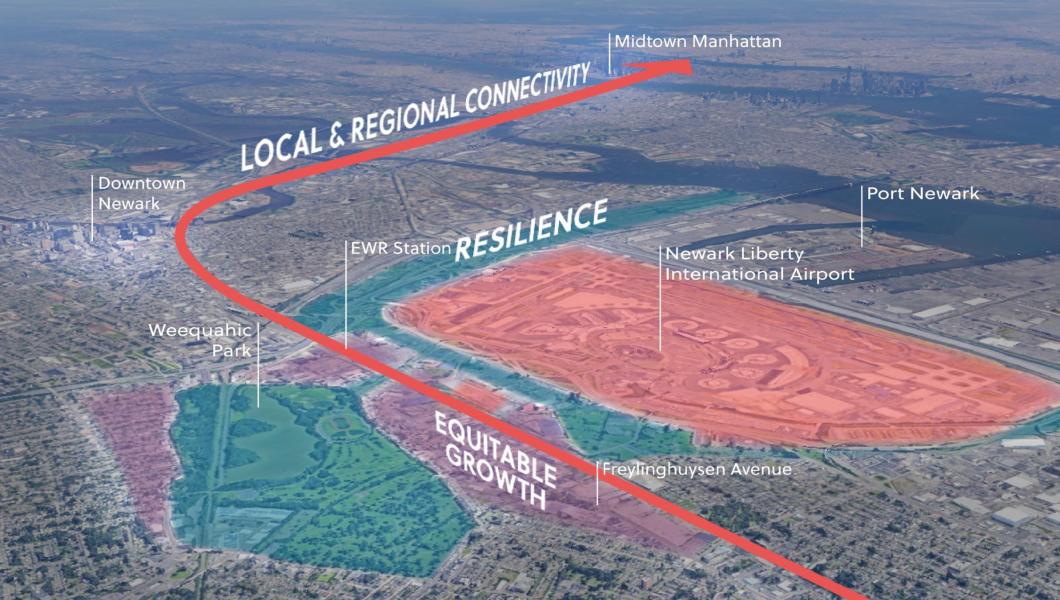NJIT Architecture Professors and Students Help Launch Newark's Hope Village II

New Jersey Institute of Technology’s Hillier College of Architecture and Design (HCAD) was present on Monday as Mayor Ras J. Baraka, and the director of the Mayor’s Office of Homeless Services Luis Ulerio opened the second iteration of Hope Village, “Come As You Are” Bridge Housing Community, located on Elizabeth Avenue.
Hope Village II is a safe haven for the chronically homeless, where they will be provided services to help them transition to permanent affordable housing. The housing community will provide 20 residents their own rooms, with a bathroom, shower, refrigerator and microwave oven shared by just five people.
HCAD professors of practice Erin Pellegrino and Charlie Firestone, along with their students, designed and built the welcome booth, located at the entrance of Hope Village II.
“The collaboration started as a continuation of POD One, which was the first studio we did which looked at reimagining a dwelling unit for Hope Village I,” said Pellegrino. “In meeting with the residents there and members of the city, we decided to look at another way that we could collaborate.”
Hope Village I, a 28-unit project, has placed over 50 formerly homeless people into permanent housing since it opened in March 2021.
“Hope Village II was already designed and under development, but we had learned through understanding Hope Village I that there was no real place for the residents to get together, there was no real humanized way for them to come in and go through security,” shared Pellegrino. “So we spoke to Luis Ulerio and proposed getting together and redesigning the entry sequence to the village that would involve an actual welcome booth, not just a security booth and then a way to make the screening process a little bit more humane and dignified.”
Fifth-year architecture student, Kenia Suarez, highlighted Pellegrino and Firestone’s guidance throughout the process of building the structure.
“Working with Erin and Charlie has been an amazing experience,” she said. “I've had them for two semesters, and in both of them they have known how to guide me, and how to make things work. The tools that they give you, and how they make you feel like a colleague instead of just a regular student. There's hierarchy, but with them, it's an open book, you can communicate really well and they guide you very well to have a successful design.”
The students’ involvement was twofold. One, they got to work with a client and actually present their ideas to people who are going to use their project, and second, they built it.
“The hands-on knowledge of drawing what they're intending to do, and then going out and trying to actually build it, that's a huge undertaking and a huge learning curve for them, but at the same time because they get to meet the client, and they get to meet the residents, that's a drive to work through a lot of those more difficult aspects of turning your design into reality and creating a space that you can stand in,” said Pellegrino.
Another fifth-year architecture student, Alex Corman, mentioned how important the community outreach helped in creating the welcome booth.
“We did a lot of community engagement,” said Corman. “We did a lot of talking with the community and figuring out what they actually wanted and what they needed. Figuring out design aspects that would bring life to the community a little bit and to see it actually built — I can definitely see that we accomplish that.”
In December 2022, Newark launched its first homelessness strategic plan “The Path Home: Collaborating Across Our Community.” In the first year, the city saw a 57.6% decrease in the unsheltered population, according to the state’s Department of Community Affairs.
Baraka thanked NJIT’s engagement in this strategic plan and announced that Hope Village III will be designed and built by NJIT architectural students.
Tiny-House-4MB-005-sqaure.jpg

“The third iteration of this is created by the NJIT students, architectural students,” said Baraka. “It’s going to be even better than this. So I appreciate all of you for coming out today.
“I'm glad we get to cut a ribbon, and I drove past it every day. I live up the street, so I saw from the beginning to the end, and the end looks a lot better than the beginning.”
“It's been a really great experience, that we've been able to have a fingerprint on Hope Village I, Hope Village II and Hope Village III,” said Pellegrino. “Hope Village III was actually designed the entirety of it by our students, so that was a research studio that looked at how we could lay out the entire site, how we could lay out the entry spaces, the community spaces, and hopefully that'll be the one that gets built next.”

